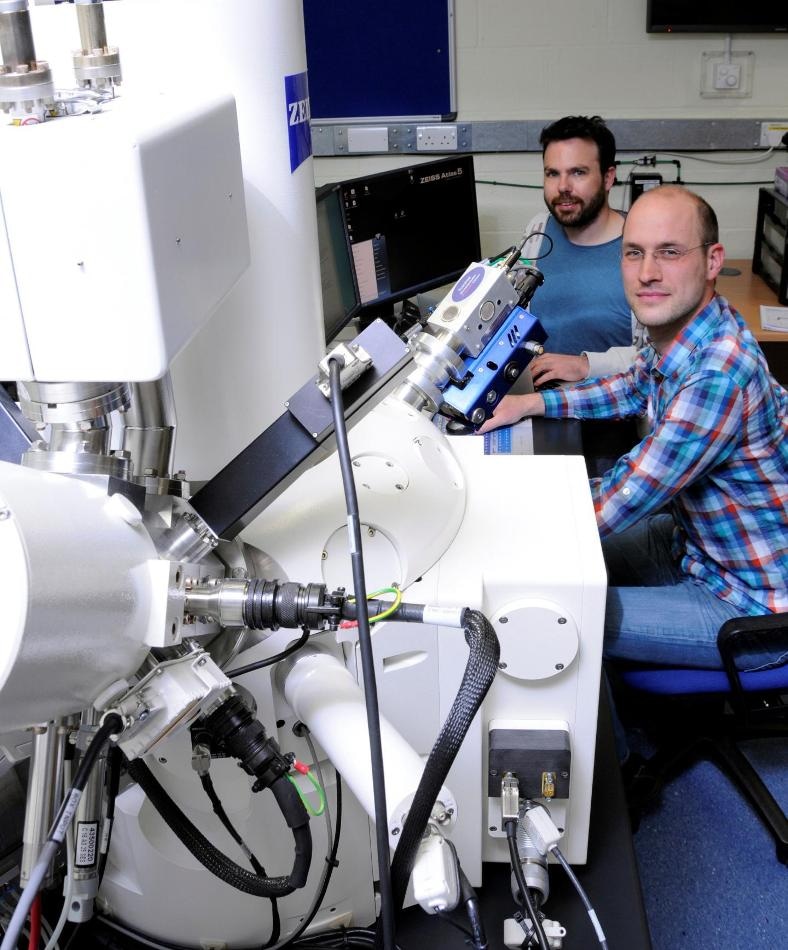Apr 21 2017
 Felix Hofmann and Edmund Tarleton, both authors of the paper, at the FIB instrument at the Department of Materials, University of Oxford, UK. (CREDIT - Oxford University)
Felix Hofmann and Edmund Tarleton, both authors of the paper, at the FIB instrument at the Department of Materials, University of Oxford, UK. (CREDIT - Oxford University)
A method that transformed scientists' ability to control and study materials at the nanoscale may have dramatic involuntary consequences, a new Oxford University research reveals.
Focused Ion Beam Milling (FIB) applies a miniature beam of highly energetic particles to cut and analyze materials smaller than one thousandth of a strand of human hair.
This extraordinary ability changed scientific fields such as materials science, biology, engineering, and earth sciences. FIB is currently a vital tool for several applications including; researching high performance alloys for nuclear, aerospace engineering, and automotive applications and for prototyping in micro-fluidics and micro-electronics.
FIB was earlier thought to cause structural damage inside a thin surface layer (tens of atoms thick) of the material being cut. Thus far it was believed that the effects of FIB would not spread beyond this thin damaged layer. Revolutionary new results from the University of Oxford show that this is not true, and that FIB can in fact greatly change the structural identity of a material. This research was performed along with colleagues from Argonne National Laboratory, USA, LaTrobe University, Australia, and the Culham Centre for Fusion Energy, UK.
In research recently published in the Scientific Reports journal, the team investigated the damage caused by FIB using a method known as coherent synchrotron X-ray diffraction. This is based on ultra-bright high energy X-rays, available only at central facilities such as the Advanced Photon Source at Argonne National Lab, USA. These X-rays are capable of probing the 3D structure of materials at the nanoscale. The results reveal that even extremely low FIB doses, formerly thought negligible, have a significant effect.
Felix Hofmann, Associate Professor in Oxford's Department of Engineering Science and lead author on the study, said, "Our research shows that FIB beams have much further-reaching consequences than first thought, and that the structural damage caused is considerable. It affects the entire sample, fundamentally changing the material. Given the role FIB has come to play in science and technology, there is an urgent need to develop new strategies to properly understand the effects of FIB damage and how it might be controlled."
Before the progress of FIB, sample preparation methods were less, only sections could be prepared from the material bulk, but not from specific attributes. FIB changed this field by enabling miniature coupons to be cut out from specific sites in a material. This advancement enabled scientists to study specific material property using high-resolution electron microscopes. Moreover, it allowed mechanical testing of miniature material specimens, a requisite for the research of hazardous or extremely precious materials.
Although wanting his peers to regard the serious consequence of FIB, Professor Hofmann said, "The scientific community has been aware of this issue for a while now, but no one (myself included) realised the scale of the problem. There is no way we could have known that FIB had such invasive side effects. The technique is integral to our work and has transformed our approach to prototyping and microscopy, completely changing the way we do science. It has become a central part of modern life."
Going forward, the team is committed to raising awareness of FIB damage. Also, they will build upon their present work to obtain a better understanding of the damage caused and how it can be eliminated.
We're learning how to get better. We have gone from using the technique blindly, to working out how we can actually see the distortions caused by FIB. Next we can consider approaches to mitigate FIB damage. Importantly the new X-ray techniques that we have developed will allow us to assess how effective these approaches are. From this information we can then start to formulate strategies for actively managing FIB damage.
Professor Hofmann, Associate Professor, Department of Engineering Science, Oxford University